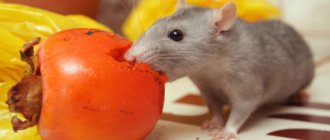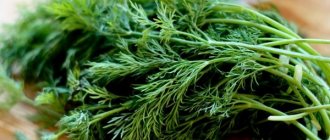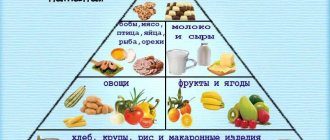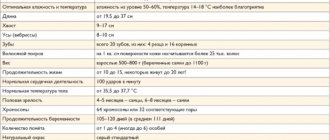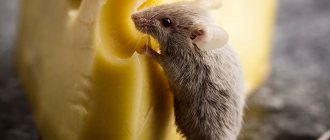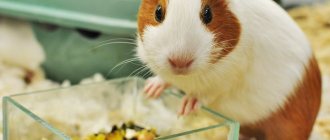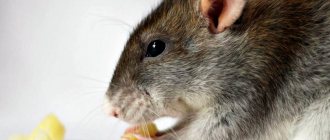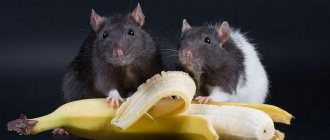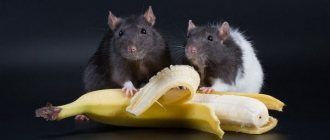It is very important for rat owners to know what to feed their pets. Of course, in pet stores you can find food for complete nutrition of a rodent. However, sometimes it is worth pampering your pet with a variety of foods. In this case, you will need to research all available information to ensure that the food is suitable for your rat.
In this article, we will look at different categories of products and their safety for rodents. If the food you are interested in is not on this list, look online for more information. Always check food is safe for your pet before feeding. You cannot know if a food is toxic or poisonous to a rat.
Prohibited Products
For the most part, rats can be given regular food, but there are exceptions:
- Dry peanuts or beans - they contain substances that eliminate the beneficial properties of enzymes and vitamin A necessary for the body to process protein and starch, and can also cause blood cells to stick together;
- Green bananas - destroy enzymes responsible for the absorption of starch;
- Potato eyes and skins contain solanine, known for its toxic properties;
- Raw tofu – it contains many bacteria that are not found in cooked tofu;
- Orange juice - not suitable for consumption only by males, can weaken the kidneys;
- Apple seeds - they contain a low concentration of cyanide, which is dangerous for pets;
- Artichoke – inhibits protein processing in the rat's body;
- Beans - destroys enzymes and vitamin A;
- Beet tops - can cause ailments of the urinary system and provoke the formation of stones in the kidneys and bladder due to the large amount of oxalates;
- Chocolate – contains too much sugar.
Alternative to apples
So your rat doesn't like apples. Fortunately, because rats can eat many different foods, this is not a problem. Here are some alternatives you can give your rat as a treat:
- Grape
- Bananas
- Blueberry
- Tomatoes
- Some types of salad
- A pineapple
- A small amount of bread
- Strawberry
- Pumpkin
- Carrot
Keep in mind that this list is not complete, it is only intended to give you some ideas. If you want an expanded understanding of what rats can eat, check out the article on rat nutrition.
Vegetables and greens
You can feed your rat the following vegetables and herbs:
- Cabbage is the most common vegetable to feed to rodents, as it can be given every day;
- Spinach – good for growing rat pups, give once a week;
- Broccoli – improves overall health, recommended twice a week;
- Cauliflower – pets love to eat this vegetable raw, feed it twice a week;
- Asparagus – has a good preventative effect against anemia; you can feed it to your rat three times a week;
- Carrots – contains many vitamins, often used for training;
- Cucumber – you can take it with you on the way to the veterinarian instead of water.
- Basil – give one or two leaves.
Most pet rats happily eat vegetables and greens raw. Cooking vegetables significantly reduces the concentration of micronutrients in them, so it is very important to add raw vegetables to your rodent's diet. But, if your rats specifically require boiled vegetables, then it would be better to remove this food from their diet completely.
What vegetables does a rat eat?
In addition to the fact that vegetables are very beneficial for rodents, rats really like their refreshing taste. Beginning breeders mistakenly believe that animals can be fed almost all the gifts from the garden. However, it is not. To feed your pet you need to choose the following vegetables:
- zucchini;
- pumpkin;
- cucumbers - in limited quantities due to possible gas formation;
- beets - in small portions, since the root vegetable contains a large amount of sugar;
- broccoli;
- spinach - with caution, since the leaves are rich in oxalic acid;
- asparagus (contains substances that prevent the development of tumors);
- carrot;
- Brussels sprouts;
- onions and garlic - in limited quantities, as they contain phytoncides that irritate the mucous membranes of the digestive system;
- leaf salad.
Instead of fresh and boiled vegetables, you can give your rat vegetable puree (as well as fruit and fruit-vegetable puree). In this case, you must pay attention to the expiration date of the product and do not store an open jar in the refrigerator for more than 24 hours.
There are a number of foods that are dangerous to rats when eaten raw. Therefore, before serving to your pet, you will definitely need to boil potatoes, eggplant, green beans, and sweet potatoes.
Nuts
Nuts are full of healthy fats, protein and fiber. They can be given to pets as a healthy treat. However, they should only be offered to rats in small quantities, as they contain too much fat. But the exception is chestnuts, which are low in fat and are considered the most suitable nut for rats.
We suggest adding several types of nuts to your pet's diet and alternating them - treating your rat to one of the types once a day. The following nuts are the best choices:
- Walnuts;
- Brazil nuts;
- Almond;
- Pecan;
- Pistachios.
Chestnuts are the only type of nut that can be given in large quantities and combined with other nuts.
What berries can you give?
Berries are real vitamin bombs. In addition, the small fruits are rich in antioxidants necessary to maintain good rat health. Only because of the high sugar content, they need to be given to rodents in small quantities - 1-2 pieces per day. The healthiest berries for rats are:
- strawberry;
- raspberries;
- blueberry;
- black and red currants;
- blueberry;
- elder;
- blackberry;
- cranberry;
- strawberries
When feeding rats berries, it is worth considering their acidity level. The more sour the product tastes, the more caution it should be offered, starting with minimal doses.
It is also worth keeping in mind that some berries (especially those with a large number of seeds) can cause allergic reactions. Therefore, you should not give them to your pet on an empty stomach.
Cereals and grains
Grains and cereals contain large amounts of carbohydrates and vitamin E. The most affordable option for adding such food to a rat’s diet is to buy rodent food that contains a variety of grains mixed together. However, often the pet refuses specific grains, so it is easier to prepare a mixture based on the animal's preferences.
These cereals are suitable for rats:
- Wheat;
- Barley;
- Oats;
- Millet.
It is also worth adding grains to the mixture. Choose from the following types of seeds:
- Linen;
- Sunflower;
- Pumpkin.
Before feeding, the seeds should be washed thoroughly. Seeds for rats can be germinated at home. A rodent should be given no more than 15 seeds per week.
Benefits of succulent food for rats
Plant foods should be present in the rat's diet every day. The approximate amount of succulent food per pet per day is 30 grams, of which approximately 85% is vegetables, and 15% is fruits and berries. Plant foods have the following beneficial properties:
- Acts as an additional source of moisture. Everyone knows that without fluid normal metabolism is impossible. Sometimes active rodents can get carried away and ignore the drinker. In such situations, there is no need to worry if the animal has received a sufficient amount of succulent food. The moisture deficit will be restored in full. Fruits and vegetables are especially refreshing in the summer heat.
- Contains a large amount of fiber. Rats often suffer from problems with their digestive system. Coarse plant fibers help start the processes of food digestion and also increase intestinal motility, normalizing stool. Fiber also lowers cholesterol levels in the blood, preventing heart attack and stroke.
- It is a natural source of micro- and macroelements. Store-bought vitamin and mineral complexes are clearly inferior in quality to natural food containing sufficient amounts of vitamins and minerals. Daily consumption of succulent food significantly increases the immunity of rodents, protecting them from various diseases.
- Contains antioxidants that help destroy and remove carcinogenic substances from the body. This is especially true for rats, since decorative rodents are prone to the development of neoplasms, both benign and malignant.
- It has low calorie content and does not overload the stomach. Eating vegetables, fruits and berries is an excellent prevention of obesity in rats. Even simple sugars contained in plant foods are completely broken down in the body and do not harm the animal.
It is worth noting that the listed beneficial properties are characteristic only of seasonal berries, vegetables and fruits grown without the use of nitrates and other harmful additives. It is best if the succulent food for the rat was collected from your own garden plot.
Before offering your rat fruits and vegetables, it is recommended to peel the fruits. New products should be introduced gradually, observing the reaction of the fluffy.
Fruits and dried fruits
Fruits are very beneficial for rats. However, they contain sugar, so it is important not to overdo them. Preference should be given to berries, as they are filled with nutrients, but contain the least sucrose. But there are other fruits suitable for rats. Among them:
- Apples are good for a rodent’s heart; they can be given no more than three times a week;
- Bananas are easily digested by the rat’s body, give them dried, fresh and baked;
- Plums - help rodents grow smooth fur, feed them three times a week;
- Peaches - famous for their anti-inflammatory effect, a rat can be given half the fruit at a time;
- Kiwi – helps prevent anemia and infections;
- Cherries – support the pet’s brain function, remove the pits before feeding;
- Grapes - can slow down aging, but contain a lot of sugar, so give in minimal quantities;
- Pears – useful for weight loss in large rats;
- Watermelon – can be given daily.
It is best to feed your pet rat fresh fruits and berries. Fruits that have been dried at home are also an excellent option. If you decide to purchase dried fruits in a store, check the sugar content on the packaging.
Is it possible to give a decorative rat tangerine and orange?
To begin with, it is worth noting that these 2 citrus fruits are the most allergenic of the entire family, and therefore you need to be careful with them. They are undesirable in the diet of rats. In addition to the fact that the animal may be allergic to them, they are also dangerous because they can cause ulcerative lesions of the stomach and intestines. Like people, there are rats that love citrus fruits and are not allergic.
Rat eats tangerine
In this case, you can give this treat to rodents from time to time, but in very small quantities. If you decide to try giving your rat a tangerine or orange, then you should do this without giving large pieces at once, but starting with small portions. In this case, you need to carefully monitor what reaction your pet will have.
Mushrooms
If you use mushrooms that are edible to humans, they are also safe for rats. It is recommended to serve mushrooms cooked to kill any microbes that may be on them after processing.
Additionally, it is important to feed mushrooms to rats in moderation. A small amount of mushrooms will not harm your rat and can be a tasty and healthy snack. Mushrooms have also been shown to help prevent tumors and infections in rats, so it might be a good idea to give them as a treat occasionally.
But if you feed your rat a lot of mushrooms, it can cause many side effects. Excessive feeding of mushrooms can cause gas, diarrhea and some other digestive problems in your rat. For this reason, it is best to feed mushrooms to rats in moderation.
This will diversify your rat's diet and prevent many health problems.
What smells are mice afraid of?
Experienced housewives know what smell mice don't like. Through long-term observations, they discovered that rodents cannot tolerate the aromas of certain plants, spices, synthetic fragrances and even essential oils. The mouse is also well repelled by the natural odors of animal enemies (cats, snakes, hedgehogs).
Plants
Some plants not only repel rodents with their smell, but also affect their well-being.
The following representatives of the flora are popular:
- Aroma of wormwood. This herb has a strong, persistent aroma that mice cannot tolerate. Freshly picked wormwood branches are placed around the house, especially in places where mice have left their excrement. This plant is also used to fumigate living spaces. Dry twigs are set on fire and moved from room to room. The smoke seeps into the most remote corners, driving away rodents.
- Tansy. This plant has an aroma reminiscent of camphor. Bouquets are made from it and laid out in different rooms, as well as in basements. This natural insecticide is good at repelling pests.
- Black elderberry. The root of this plant contains hydrocyanic acid, which is poisonous to both animals and humans. And elderberry branches emit an aroma that mice cannot tolerate. They are laid out in cellars and food pantries.
- Black root or dog tongue. It is a poisonous weed that helps control rodents and garden pests. Affects the nervous system of mice. They, hearing it at a fairly large distance, try to leave the room. People practically don’t feel this aroma, but it simply drives mice crazy.
- Marsh rosemary. This is a plant containing poisonous oils. If a mouse comes into contact with wild rosemary branches placed in the corners of the room, it will die in the near future. And others, sensing it from afar, hurriedly leave their home.
- Chamomile. Many people like the smell of this medicinal plant, but mice absolutely cannot stand it. Dried chamomile bouquets are placed next to food supplies. Chamomile tincture is also added to the water during cleaning.
Some of the listed plants are appropriate to plant in a personal plot. When laying them out in a house or apartment, it is important to assess where pests most often run and leave bunches of plants mainly in those places.
If it is difficult to find fresh plants, then you can buy herbal mixture or individual extracts and tinctures at the pharmacy. They are no less effective.
If dry raw materials are used, then it will be needed 2-3 times more than fresh.
If a housewife prefers poisonous plants, then she should protect herself and think about her health. It is advisable to use rubber gloves, a respirator and protective clothing.
Upon completion of work aimed at combating rodents, protective equipment should be thrown away, burned or washed very well.
Spices
If you don’t want to tinker with plants, then food spices, available in any housewife’s kitchen, can be an alternative aromatic means of control.
Mice will avoid food supplies if they smell the following odors:
- clove;
- coriander or cilantro;
- chili pepper;
- sage
Mice also don't like bay leaves. It is effective to use these spices whole or crushed. A persistent aroma appears that repels rodents when sage leaves are burned. The smell of coffee, especially recently roasted coffee, also repels pests.
Liquids with a strong odor
Voles cannot tolerate the smell of the following liquids:
- Ammonia solution. Fill a saucer with ammonia and place it near the mink. This product is also used to wipe various surfaces where rodents have been spotted. To prepare a working solution, combine 10 ml of ammonia with 1 liter of water. This smell reliably repels mice.
- Vinegar. This product is available in any kitchen. The saucer is filled with pure vinegar or diluted with water and placed near the minks. They also use a vinegar solution to thoroughly clean the room. The product will effectively repel mice if its persistent aroma persists for a long time.
- The smell of tar. People also do not tolerate this aroma well, so this method of repelling mice is more suitable for non-residential premises. If housewives want to use it at home, then they can arrange to stay with relatives or friends for a while. Dampen a rag with tar and then place it where rodents are most likely to be. Gasoline, kerosene, and car oil have similar repelling properties.
- Chlorine smell. Any pests do not like products with a strong chlorine scent. Products containing chlorine are used to clean floors 3-4 times a week.
The listed products are good for protecting against mice in the country. It is advisable to use them when closing it for the winter.
Synthetic flavors
More toxic products are also popular. This could be feed sulfur or a smoke bomb. The poisonous gas has a detrimental effect on rodents. It instantly poisons mice by affecting the mucous membrane of their eyes, nose or mouth.
The following “flavors” are sometimes used to pickle a cottage, cellar or attic:
- burnt fluff, wool;
- aviation kerosene;
- burnt tires;
- naphthalene;
- colognes that were produced back in the days of the Soviet Union.
When fighting mice, it is important to ensure that the listed substances do not enter the human body. They can cause irreparable harm. When using such “flavors,” it is advisable to wear a gas mask or respirator.
After treating the room, close it tightly so that fresh air does not penetrate there. It is better to refrain from visiting this room for 7 days. The smell should disappear on its own.
Fragrant oils
You can use essential oils against mice. Plant extracts have a persistent odor and often last much longer than freshly picked plants. It is enough to apply 2-3 drops of essential oil to the fabric, and then place it where the mouse droppings were noticed.
When using aromatherapy, it is important to remember that essential oils can provoke the development of allergic reactions in family members.
But if no problems arise, then you can choose the essential oil of mint, tansy or chamomile. Mice especially cannot tolerate them.
Video
How to get rid of Mice The most pleasant way!
Cheese and other dairy products
Dairy products and eggs can be added to a rat's diet. The pet is allowed to give quail eggs once a week. They must be hard-boiled first. Natural yogurt with a low fat content is also suitable as a treat for a rodent. However, make sure that no flavorings or other additives have been added to the product.
You should be especially careful with full-fat milk and cheese. It is recommended to give a very small amount of cheese. Also, the best type of cheese for rats is the one made from soy. Never feed blue cheese to your pet; it is toxic to pets. You can also supplement your rodent's diet with fish oil, which is very beneficial for small animals.
Can rats have milk?
Many rats love fermented milk products. They can also be considered as a source of animal protein, calcium and other benefits. However, many rats cannot digest lactose due to a lack of the enzyme lactase. Dairy products cause strong fermentation in their intestines, and as a result - bloating and diarrhea.
Rats are strictly not given whole milk, as well as dairy products that are too fatty (10-20% sour cream, cream). The best option is fermented milk products with a fat content of up to 5%, without flavorings or any additives. They should not be sweet.
Rats can be given as treats (a dessert spoon of each):
- Cottage cheese;
- Natural yogurt;
- Ryazhenka, acidophilus, narine.
If your pet has not received dairy products before, you need to start with small portions and monitor how you feel afterwards. Fermented milk is given on days when rats do not receive protein complementary foods (meat, eggs), either separately or as a reward.
The clever thief was attracted by the remains of milk at the bottom of the glass
Meat
Meat and fish are recognized as the main sources of protein. It is also very important to introduce hearts, kidneys, liver and tubular bones of birds into the diet of a domestic rat. Feed your pet only meat and fish that are not too fatty. The best feeding option is pre-boiled meat, cut into small pieces. Never give your animal high-temperature food; wait until the meat cools down. It is worth noting that frozen meat is not suitable for feeding rats. An excellent addition to a healthy rat diet would be low-fat broth without various spices and additives.
Special food
While shopping for standard food, you can also look for products specifically formulated for pet rats.
They are usually a food made from nutritious plant pellets. These loose seed mixtures can provide a balanced diet for your pet, but only if your rat eats the entire contents of the food. However, rodents often eat only the most delicious food and leave half of the food at the bottom of the bowl. Therefore, rat food in the form of a block is an excellent option. The pet will not be able to selectively eat a certain part of the food, and food will always be available to it.
What do you feed domestic rats: diet composition
A high-quality grain mixture is the basis of the diet of domestic rats. The easiest way is to choose ready-made high-quality food rather than making the mash yourself. Food is given ad libitum, without restrictions. An adult rat eats about 30 grams per day.
In addition to grain, the rat menu must include succulent food - vegetables or fruits, green salads. Protein complementary foods are also needed, especially for young animals during the growth period, pregnant or lactating females.
As a reward for training and just to pamper your pets, they use various seeds and nuts, unsweetened popcorn, banana chips and much more. Treats should make up a tiny part of the diet.
Why does it smell so good?
Domestic rats are fed something like this:
- 60% grain mixture (feed)
- 20% vegetables and unsweetened fruits, greens
- 10% protein food (meat, eggs)
- 5% fermented milk products
- 5% treats
Example of a diet for rats: dry food on the right, protein and succulent food on the left
Now let's take a closer look at each section.
